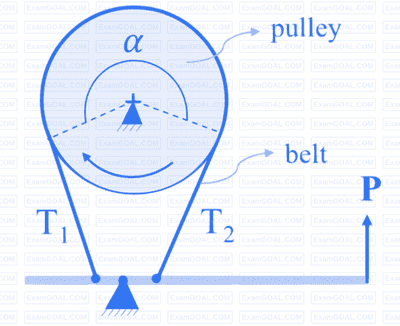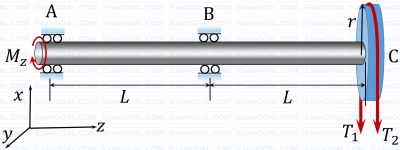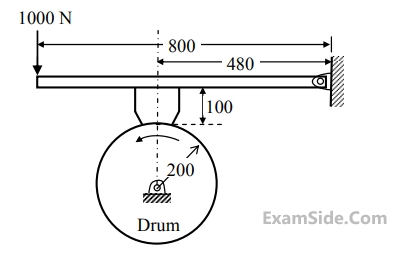Design of Brakes and Clutches · Machine Design · GATE ME
Marks 1
The braking system shown in the figure uses a belt to slow down a pulley rotating in the clockwise direction by the application of a force P. The belt wraps around the pulley over an angle α = 270 degrees. The coefficient of friction between the belt and the pulley is 0.3. The influence of centrifugal forces on the belt is negligible.
During braking, the ratio of the tensions T1 to T2 in the belt is equal to __________. (Rounded off to two decimal places)
Take π = 3.14.



Marks 2
A solid massless cylindrical member of 50 mm diameter is rigidly attached at one end, and is subjected to an axial force $P = 100$ kN and a torque $T = 600$ N.m at the other end as shown. Assume that the axis of the cylinder is normal to the support.
Considering distortion energy theory with allowable yield stress as $300$ MPa, the factor of safety in the design is _____ (rounded off to 1 decimal place).

A band brake shown in the figure has a coefficient of friction of 0.3. The band can take a maximum force of 1.5 kN. The maximum braking force (F) that can be safely applied is _______ N (rounded off to the nearest integer).

A shaft AC rotating at a constant speed carries a thin pulley of radius r = 0.4 m at the end C which drives a belt. A motor is coupled at the end A of the shaft such that it applies a torque M, about the shaft axis without causing any bending moment. The shaft is mounted on narrow frictionless bearings at A and B where AB = BC = L = 0.5 m. The taut and slack side tensions of the belt are T1 = 300 N and T2 = 100 N, respectively. The allowable shear stress for the shaft material is 80 MPa. The self-weights of the pulley and the shaft are negligible. Use the value of π available in the on-screen virtual calculator. Neglecting shock and fatigue loading and assuming maximum shear stress theory, the minimum required shaft diameter is mm (round off to 2 decimal places).






The maximum tension that can be generated in the band during braking is

The maximum wheel torque that can be completely braked is